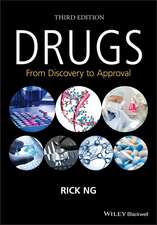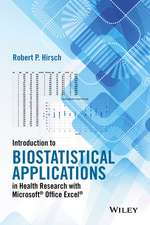Regression Methods in Biostatistics: Linear, Logistic, Survival, and Repeated Measures Models: Statistics for Biology and Health
Autor Eric Vittinghoff, David V. Glidden, Stephen C. Shiboski, Charles E. McCullochen Limba Engleză Hardback – sep 2011
Treating these topics together takes advantage of all they have in common. The authors point out the many-shared elements in the methods they present for selecting, estimating, checking, and interpreting each of these models. They also show that these regression methods deal with confounding, mediation, and interaction of causal effects in essentially the same way.
The examples, analyzed using Stata, are drawn from the biomedical context but generalize to other areas of application. While a first course in statistics is assumed, a chapter reviewing basic statistical methods is included. Some advanced topics are covered but the presentation remains intuitive. A brief introduction to regression analysis of complex surveys and notes for further reading are provided.
| Toate formatele și edițiile | Preț | Express |
|---|---|---|
| Paperback (1) | 651.84 lei 6-8 săpt. | |
| Springer – 13 apr 2014 | 651.84 lei 6-8 săpt. | |
| Hardback (1) | 633.23 lei 3-5 săpt. | +36.89 lei 6-12 zile |
| Springer – sep 2011 | 633.23 lei 3-5 săpt. | +36.89 lei 6-12 zile |
Din seria Statistics for Biology and Health
- 17%
 Preț: 352.01 lei
Preț: 352.01 lei - 20%
 Preț: 776.71 lei
Preț: 776.71 lei - 20%
 Preț: 1376.32 lei
Preț: 1376.32 lei - 18%
 Preț: 1394.84 lei
Preț: 1394.84 lei - 18%
 Preț: 883.59 lei
Preț: 883.59 lei - 5%
 Preț: 843.91 lei
Preț: 843.91 lei -
 Preț: 397.16 lei
Preț: 397.16 lei - 20%
 Preț: 1002.67 lei
Preț: 1002.67 lei - 18%
 Preț: 1395.32 lei
Preț: 1395.32 lei - 5%
 Preț: 1102.10 lei
Preț: 1102.10 lei - 5%
 Preț: 874.83 lei
Preț: 874.83 lei - 15%
 Preț: 657.39 lei
Preț: 657.39 lei - 18%
 Preț: 960.93 lei
Preț: 960.93 lei - 15%
 Preț: 585.90 lei
Preț: 585.90 lei - 5%
 Preț: 852.69 lei
Preț: 852.69 lei - 18%
 Preț: 903.62 lei
Preț: 903.62 lei - 5%
 Preț: 721.40 lei
Preț: 721.40 lei - 15%
 Preț: 653.46 lei
Preț: 653.46 lei - 18%
 Preț: 2114.90 lei
Preț: 2114.90 lei - 18%
 Preț: 1108.99 lei
Preț: 1108.99 lei - 5%
 Preț: 821.39 lei
Preț: 821.39 lei - 5%
 Preț: 849.02 lei
Preț: 849.02 lei - 15%
 Preț: 653.14 lei
Preț: 653.14 lei - 18%
 Preț: 958.56 lei
Preț: 958.56 lei - 5%
 Preț: 722.69 lei
Preț: 722.69 lei - 18%
 Preț: 728.74 lei
Preț: 728.74 lei - 18%
 Preț: 943.22 lei
Preț: 943.22 lei - 5%
 Preț: 1092.43 lei
Preț: 1092.43 lei - 15%
 Preț: 594.21 lei
Preț: 594.21 lei - 5%
 Preț: 377.87 lei
Preț: 377.87 lei - 18%
 Preț: 1124.60 lei
Preț: 1124.60 lei - 18%
 Preț: 1220.12 lei
Preț: 1220.12 lei - 15%
 Preț: 632.98 lei
Preț: 632.98 lei - 18%
 Preț: 1394.84 lei
Preț: 1394.84 lei -
 Preț: 389.11 lei
Preț: 389.11 lei - 18%
 Preț: 959.98 lei
Preț: 959.98 lei
Preț: 633.23 lei
Preț vechi: 791.54 lei
-20% Nou
Puncte Express: 950
Preț estimativ în valută:
121.17€ • 126.51$ • 100.28£
121.17€ • 126.51$ • 100.28£
Carte disponibilă
Livrare economică 14-28 martie
Livrare express 27 februarie-05 martie pentru 46.88 lei
Preluare comenzi: 021 569.72.76
Specificații
ISBN-13: 9781461413523
ISBN-10: 1461413524
Pagini: 550
Ilustrații: XX, 509 p.
Dimensiuni: 155 x 235 x 35 mm
Greutate: 0.93 kg
Ediția:2nd ed. 2012
Editura: Springer
Colecția Springer
Seria Statistics for Biology and Health
Locul publicării:New York, NY, United States
ISBN-10: 1461413524
Pagini: 550
Ilustrații: XX, 509 p.
Dimensiuni: 155 x 235 x 35 mm
Greutate: 0.93 kg
Ediția:2nd ed. 2012
Editura: Springer
Colecția Springer
Seria Statistics for Biology and Health
Locul publicării:New York, NY, United States
Public țintă
ResearchCuprins
Introduction.- Exploratory and Descriptive Methods.- Basic Statistical Methods.- Linear Regression.- Logistic Regression.- Survival Analysis.- Repeated Measures Analysis.- Generalized Linear Models.- Strengthening Casual Inference.- Predictor Selection.- Complex Surveys.- Summary.
Recenzii
From the reviews:
"This book provides a unified introduction to the regression methods listed in the title...The methods are well illustrated by data drawn from medical studies...A real strength of this book is the careful discussion of issues common to all of the multipredictor methods covered." Journal of Biopharmaceutical Statistics, 2005
"This book is not just for biostatisticians. It is, in fact, a very good, and relatively nonmathematical, overview of multipredictor regression models. Although the examples are biologically oriented, they are generally easy to understand and follow...I heartily recommend the book" Technometrics, February 2006
"Overall, the text provides an overview of regression methods that is particularly strong in its breadth of coverage and emphasis on insight in place of mathematical detail. As intended, this well-unified approach should appeal to students who learn conceptually and verbally." Journal of the American Statistical Association, March 2006
"This book is … about regression methods, with examples and terminology from the biostatistics field. It should, however, also be useful for practitioners from other disciplines where regression methods can be applied. … Most chapters end with a Problems section, and a section of further notes and references, making the book suitable as a text for a course on regression methods for Ph. D. students in medicine … . Many of the analyses in the book are illustrated with output from the statistical package Stata." (Göran Broström, Zentralblatt MATH, Vol. 1069, 2005)
"The authors have written have written the book with the intention to provide an accessible introduction to multipredictor methods, emphasizing their proper use and interpretation. … In summary it may be said that this book is excellently readable. Because of the … detailed aspects of modeling, the applied tips as well as many medical examples, it can berecommended ... . In addition it can be recommended as background literature for biometrics advisors because of the high didactic quality of the book." (Rainer Muche, ISBC Newsletter, Issue 42, 2006)
"The authors have written a very readable book focusing on the most widely used regression models in biostatistics: Multiple linear regression, logistic regression and Cox regression. … The book is written for a non-statistical audience, focusing on ideas and how to interpret results … . The book will be … useful as a reference to give to a non-statistical colleague … ." (Soren Feodor Nielsen, Journal of Applied Statistics, Vol. 33 (6), 2006)
"Readership: Biostatistics readers, post-graduate research physicians. … This text is nicely written and well arranged and provides excellent, reasonably brief, information on the selected-topics." (N. R. Draper, Short Book Reviews, Vol. 25 (2), 2005)
"This book is designed for those who want to use statistical tools in the biosciences. … It provides an excellent exposition of the application of different tools of regression analysis in biostatistics. … This book can be a bridge between biostatistics and regression analysis … . Survival analysis, repeated measurement analysis and generalized linear models are covered comprehensively. It could be used as a text-book for an advanced course in biostatistics, and it will also be helpful to biostatisticians … ." (Shalabh, Journal of the Royal Statistical Society, Vol. 169 (1), 2006)
"The focus is on understanding key statistical and analytical concepts--interpreting regression coefficients, understanding the impact of the failure of model assumptions, grasping how correlation in clustered sample designs affects analysis--rather than on mathematical derivations." (Michael Elliott, Biometrics, December 2006)
"This book provides a unified introduction to the regression methods listed in the title...The methods are well illustrated by data drawn from medical studies...A real strength of this book is the careful discussion of issues common to all of the multipredictor methods covered." Journal of Biopharmaceutical Statistics, 2005
"This book is not just for biostatisticians. It is, in fact, a very good, and relatively nonmathematical, overview of multipredictor regression models. Although the examples are biologically oriented, they are generally easy to understand and follow...I heartily recommend the book" Technometrics, February 2006
"Overall, the text provides an overview of regression methods that is particularly strong in its breadth of coverage and emphasis on insight in place of mathematical detail. As intended, this well-unified approach should appeal to students who learn conceptually and verbally." Journal of the American Statistical Association, March 2006
"This book is … about regression methods, with examples and terminology from the biostatistics field. It should, however, also be useful for practitioners from other disciplines where regression methods can be applied. … Most chapters end with a Problems section, and a section of further notes and references, making the book suitable as a text for a course on regression methods for Ph. D. students in medicine … . Many of the analyses in the book are illustrated with output from the statistical package Stata." (Göran Broström, Zentralblatt MATH, Vol. 1069, 2005)
"The authors have written have written the book with the intention to provide an accessible introduction to multipredictor methods, emphasizing their proper use and interpretation. … In summary it may be said that this book is excellently readable. Because of the … detailed aspects of modeling, the applied tips as well as many medical examples, it can berecommended ... . In addition it can be recommended as background literature for biometrics advisors because of the high didactic quality of the book." (Rainer Muche, ISBC Newsletter, Issue 42, 2006)
"The authors have written a very readable book focusing on the most widely used regression models in biostatistics: Multiple linear regression, logistic regression and Cox regression. … The book is written for a non-statistical audience, focusing on ideas and how to interpret results … . The book will be … useful as a reference to give to a non-statistical colleague … ." (Soren Feodor Nielsen, Journal of Applied Statistics, Vol. 33 (6), 2006)
"Readership: Biostatistics readers, post-graduate research physicians. … This text is nicely written and well arranged and provides excellent, reasonably brief, information on the selected-topics." (N. R. Draper, Short Book Reviews, Vol. 25 (2), 2005)
"This book is designed for those who want to use statistical tools in the biosciences. … It provides an excellent exposition of the application of different tools of regression analysis in biostatistics. … This book can be a bridge between biostatistics and regression analysis … . Survival analysis, repeated measurement analysis and generalized linear models are covered comprehensively. It could be used as a text-book for an advanced course in biostatistics, and it will also be helpful to biostatisticians … ." (Shalabh, Journal of the Royal Statistical Society, Vol. 169 (1), 2006)
"The focus is on understanding key statistical and analytical concepts--interpreting regression coefficients, understanding the impact of the failure of model assumptions, grasping how correlation in clustered sample designs affects analysis--rather than on mathematical derivations." (Michael Elliott, Biometrics, December 2006)
Notă biografică
The authors are on the faculty in the Division of Biostatistics, Department of Epidemiology and Biostatistics, University of California, San Francisco, and are authors or co-authors of more than 200 methodological as well as applied papers in the biological and biomedical sciences. The senior author, Charles E. McCulloch, is head of the Division and author of Generalized Linear Mixed Models (2003), Generalized, Linear, and Mixed Models (2000), and Variance Components (1992).
Textul de pe ultima copertă
This new edition provides a unified, in-depth, readable introduction to the multipredictor regression methods most widely used in biostatistics: linear models for continuous outcomes, logistic models for binary outcomes, the Cox model for right-censored survival times, repeated-measures models for longitudinal and hierarchical outcomes, and generalized linear models for counts and other outcomes.
Treating these topics together takes advantage of all they have in common. The authors point out the many-shared elements in the methods they present for selecting, estimating, checking, and interpreting each of these models. They also show that these regression methods deal with confounding, mediation, and interaction of causal effects in essentially the same way.
The examples, analyzed using Stata, are drawn from the biomedical context but generalize to other areas of application. While a first course in statistics is assumed, a chapter reviewing basic statistical methods is included. Some advanced topics are covered but the presentation remains intuitive. A brief introduction to regression analysis of complex surveys and notes for further reading are provided. For many students and researchers learning to use these methods, this one book may be all they need to conduct and interpret multipredictor regression analyses.
In the second edition, the authors have substantially expanded the core chapters, including new coverage of exact, ordinal, and multinomial logistic models, discrete time and competing risks survival models, within and between effects in longitudinal models, zero-inflated Poisson and negative binomial models, cross-validation for prediction model selection, directed acyclic graphs, and sample size, power and minimum detectable effect calculations; Stata code is also updated. In addition, there are new chapters on methods for strengthening causal inference, including propensity scores, marginal structural models, and instrumental variables, and on methods for handling missing data, using maximum likelihood, multiple imputation, inverse weighting, and pattern mixture models.
From the reviews of the first edition: "This book provides a unified introduction to the regression methods listed in the title...The methods are well illustrated by data drawn from medical studies...A real strength of this book is the careful discussion of issues common to all of the multipredictor methods covered."
Journal of Biopharmaceutical Statistics, 2005
"This book is not just for biostatisticians. It is, in fact, a very good, and relatively nonmathematical, overview of multipredictor regression models. Although the examples are biologically oriented, they are generally easy to understand and follow...I heartily recommend the book"
Technometrics, February 2006
"Overall, the text provides an overview of regression methods that is particularly strong in its breadth of coverage and emphasis on insight in place of mathematical detail. As intended, this well-unified approach should appeal to students who learn conceptually and verbally."
Journal of the American Statistical Association, March 2006
Treating these topics together takes advantage of all they have in common. The authors point out the many-shared elements in the methods they present for selecting, estimating, checking, and interpreting each of these models. They also show that these regression methods deal with confounding, mediation, and interaction of causal effects in essentially the same way.
The examples, analyzed using Stata, are drawn from the biomedical context but generalize to other areas of application. While a first course in statistics is assumed, a chapter reviewing basic statistical methods is included. Some advanced topics are covered but the presentation remains intuitive. A brief introduction to regression analysis of complex surveys and notes for further reading are provided. For many students and researchers learning to use these methods, this one book may be all they need to conduct and interpret multipredictor regression analyses.
In the second edition, the authors have substantially expanded the core chapters, including new coverage of exact, ordinal, and multinomial logistic models, discrete time and competing risks survival models, within and between effects in longitudinal models, zero-inflated Poisson and negative binomial models, cross-validation for prediction model selection, directed acyclic graphs, and sample size, power and minimum detectable effect calculations; Stata code is also updated. In addition, there are new chapters on methods for strengthening causal inference, including propensity scores, marginal structural models, and instrumental variables, and on methods for handling missing data, using maximum likelihood, multiple imputation, inverse weighting, and pattern mixture models.
From the reviews of the first edition: "This book provides a unified introduction to the regression methods listed in the title...The methods are well illustrated by data drawn from medical studies...A real strength of this book is the careful discussion of issues common to all of the multipredictor methods covered."
Journal of Biopharmaceutical Statistics, 2005
"This book is not just for biostatisticians. It is, in fact, a very good, and relatively nonmathematical, overview of multipredictor regression models. Although the examples are biologically oriented, they are generally easy to understand and follow...I heartily recommend the book"
Technometrics, February 2006
"Overall, the text provides an overview of regression methods that is particularly strong in its breadth of coverage and emphasis on insight in place of mathematical detail. As intended, this well-unified approach should appeal to students who learn conceptually and verbally."
Journal of the American Statistical Association, March 2006
Caracteristici
Short and to the point so that the important issues and similarities between the methods, rather than the differences, shine through Provides a unified introduction to the regression methods listed in the title Unified approach should appeal to students who learn conceptually and verbally Includes supplementary material: sn.pub/extras













